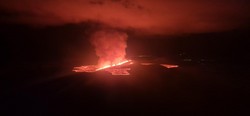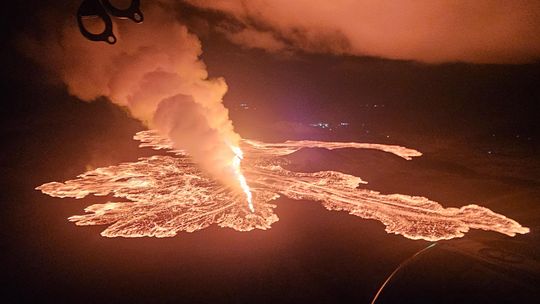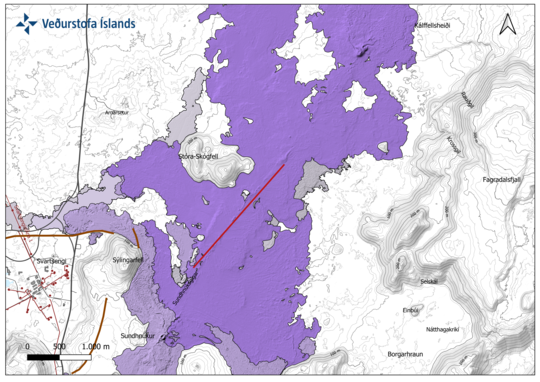- An eruption began between Stóra-Skógfell and
Sýlingarfell at 11:14 PM on 20 November - The first signs of the magma intrusion were detected
on instruments at around 10:30 PM. - The length of the eruptive fissure is estimated to be
approximately 3 km, with its southern end located near Sýlingarfell. - Gas emissions are being carried southward over
Grindavík. - Link to IMO’s gas pollution forecast
Updated at 02:10
The activity in the eruption appears to have peaked.
The fissure seems to have stopped expanding, and based on measurements from the
Icelandic Meteorological Office, there are no indications that the activity
will increase.
The length of the eruption fissure is estimated to be
about 3 km. The lava flow is spreading both eastward and westward. At this
point, the lava front is approximately 500 meters away from Grindavíkurvegur to
the west.
This eruption is significantly smaller than the last
eruption, which began on 22 August. The estimated lava flow rate at present is
about 1,300 m³/s, compared to approximately 2,500 m³/s during the August
eruption.
What stands out is that seismic activity did not start
increasing in the weeks leading up to this eruption, as was observed in
previous events. The amount of magma that had accumulated beneath Svartsengi
was similar to the amount prior to the last eruption. However, the recent trend
indicates that increasingly larger volumes of magma are required to trigger the
next event. This suggests that the pattern observed in earlier eruptions may be
changing.
(Photo: Civil Protection/Björn Oddsson)
Updated at 00:10
A small earthquake swarm began at around 10:30 PM on
20 November. This was followed by pressure changes at 10:37 PM in boreholes
operated by HS Orka. Both independent measurements were a clear sign of the
onset of a magma intrusion.
At 11:14 PM on 20 November, a volcanic fissure opened
between Stóra-Skógfell and Sýlingarfell. The fissure extended north-eastward.
Initial reports of lava-flow indicate that lava is
moving westward, south of Stóra-Skógfell. No lava flow has been observed
heading southwards towards Grindavík.
Strong northerly winds in the area are directing gas
emissions southward over Grindavík.
Map showing the estimated location of the eruptive
fissure as of 11:40 PM on 20 November. The location is based on radar data from
IMO’s radar station at Keflavík Airport.


